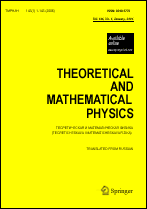|
This article is cited in 5 scientific papers (total in 5 papers)
Rayleigh wave attenuation due to scattering by stationary defects
L. A. Zaitseva
N. N. Semenov Institute of Chemical Physics, Russian Academy of Sciences
Abstract:
We obtain expressions for the energy spectrum widths of Rayleigh waves arising because of their scattering by point and distributed defects of the surface, as well as by the edge dislocations on the surface and by the grooves of a random lattice in the surface plane. The calculations are valid when the defect density is small. Under certain conditions, our results coincide with the results of other authors who studied the scattering of Rayleigh waves by point defects and by the grooves of a random lattice. The calculations are based on the Keldysh diagram technique modified for the case of semibounded media.
Keywords:
Rayleigh waves, free surface, energy spectrum width, $R$-phonon lifetime, Keldysh diagram technique.
Received: 27.07.2004
Citation:
L. A. Zaitseva, “Rayleigh wave attenuation due to scattering by stationary defects”, TMF, 143:2 (2005), 241–257; Theoret. and Math. Phys., 143:2 (2005), 689–703
Linking options:
https://www.mathnet.ru/eng/tmf1813https://doi.org/10.4213/tmf1813 https://www.mathnet.ru/eng/tmf/v143/i2/p241
|


| Statistics & downloads: |
| Abstract page: | 535 | | Full-text PDF : | 204 | | References: | 113 | | First page: | 1 |
|




 Contact us:
Contact us: Terms of Use
Terms of Use
 Registration to the website
Registration to the website Logotypes
Logotypes









 Citation in format
Citation in format 
